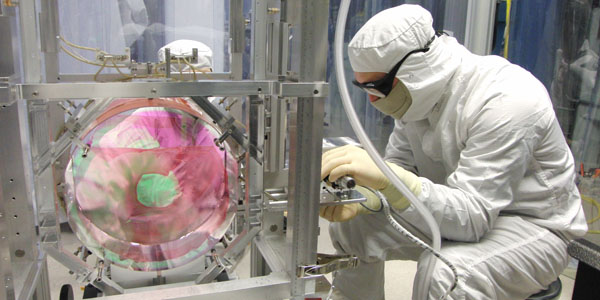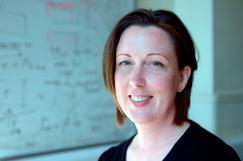UofG helps make history
Published: 11 February 2016
Researchers at the University of Glasgow have helped make history with their work on detecting gravitational waves.
Researchers at the University of Glasgow have helped make history with their work on detecting gravitational waves.
One hundred years after Albert Einstein predicted their existence, scientists have observed ripples in the fabric of spacetime called gravitational waves, arriving at the earth from a cataclysmic event in the distant universe. This confirms a major prediction of Albert Einstein’s 1915 general theory of relativity and opens an unprecedented new window onto the cosmos.
Gravitational waves carry information about their dramatic origins and about the nature of gravity that cannot otherwise be obtained. Physicists have concluded that the detected gravitational waves were produced during the final fraction of a second of the merger of two black holes to produce a single, more massive spinning black hole. This collision of two black holes had been predicted but never observed.
The gravitational waves were detected on September 14, 2015 at 5:51 a.m. Eastern Daylight Time (9:51 a.m. UTC) by both of the twin Laser Interferometer Gravitational-wave Observatory (LIGO) detectors, located in Livingston, Louisiana, and Hanford, Washington, USA. The LIGO Observatories are funded by the National Science Foundation (NSF), and were conceived, built, and are operated by Caltech and MIT.
'Monumental leap forward'
The discovery, accepted for publication in the journal Physical Review Letters, was made by the LIGO Scientific Collaboration (which includes the GEO Collaboration and the Australian Consortium for Interferometric Gravitational Astronomy) and the Virgo Collaboration using data from the two LIGO detectors.
University of Glasgow researchers have been working for decades to support the worldwide effort to detect gravitational waves, and co-led the group inside the collaboration which detected the gravitational wave signal.
Scientists from the University’s Institute for Gravitational Research led on the conception, development, construction and installation of sensitive mirror suspensions in the heart of the LIGO detectors in Livingston and Hanford, which were crucial to the first detection. That technology, developed in partnership with the University of Birmingham, the University of Strathclyde, and the STFC Rutherford Appleton Laboratory, was based on Glasgow’s pioneering work for UK/German GEO600 detector.
Those suspensions rely on delicate 400-micron-wide fibres made from silica. Despite their fragility, each suspension fibre is very strong, capable of holding up to 70 kilograms. In the LIGO detectors, the mirror suspensions hold 40kg mirrors and keep them from being interfered with any outside force or vibration except for gravitational waves. The mirrors are held so still by the suspensions that the LIGO detectors can detect movements, caused by gravitational waves, close to one-ten-thousandth the diameter of a proton. Professor Sheila Rowan, Director of the Institute for Gravitational Research, said: “This is a monumental leap forward for physics and astrophysics – taking Einstein’s predictions and turning them into an entirely new way to sense some of the most fascinating objects in our Universe.
Professor Sheila Rowan, Director of the Institute for Gravitational Research, said: “This is a monumental leap forward for physics and astrophysics – taking Einstein’s predictions and turning them into an entirely new way to sense some of the most fascinating objects in our Universe.
“In the past, we’ve relied on the information we collected from the electromagnetic spectrum to help learn more about the cosmos, from the other planets in our solar system to star systems millions of light years away.
“Now gravitational wave astronomy will give us the ability to make many exciting new discoveries. This first detection, in addition to confirming Einstein’s prediction, also gives us the first direct evidence of the existence of black holes, and the first observation of black holes merging, which is a fantastic result. We’re very much looking forward to new data from LIGO in the coming months and years, and to making our detectors even more sensitive.”
Scotland’s First Minister, Nicola Sturgeon, welcomed the announcement. She said: “This is a world leading discovery that again puts Scotland at the forefront of science.
“The University of Glasgow’s decades-long commitment to gravitational wave research is admirable, and this first detection is an impressive testament to the dedication, innovation and collaborative spirit of the scientists who work there.
“I’m pleased and proud that scientists from Scottish universities played a key role in the worldwide effort to prove that Einstein’s prediction of the existence of gravitational waves was correct.”
'Extraordinary day for University'
Professor Anton Muscatelli, Principal and Vice-Chancellor of the University of Glasgow, said: “This is an extraordinary day for the University. All of us are immensely proud of the work done by Professor Sheila Rowan and her colleagues in the Institute for Gravitational Research and the School of Physics and Astronomy. I know what a marvellous day this is for our colleagues who have devoted so much of their careers to this mission. It is truly world changing stuff! Their major role in the detection of gravitational waves will stand alongside the achievements of our great, scientific alumni: Joseph Black, James Watt, John Logie Baird, William Rankine, Jocelyn Bell Burnell and so many more. In providing final proof of Albert Einstein’s theories, an honorary graduate of this University, the discovery of gravitational waves will open up new possibilities for understanding the universe and those beyond our own. I’m sure I speak for all of us at the University in sending our congratulations and admiration to our colleagues in the Institute.”
The longest-serving member of the University’s gravitational research community is Professor James Hough, who has worked in the field at the University since 1971.
Professor Hough said: “Alongside Professor Ronald Drever, I was involved in building early gravitational wave detectors here in Glasgow, which monitored outputs from piezoelectric transducers attached to aluminium bars.
“We thought it would take us about a year to make an initial detection, and in 1972, we found what looked very much like evidence of gravitational waves. However, since no other detectors were operating at the same time, we weren’t able to verify our observation. Nonetheless, that finding convinced me that we would one day find the evidence we were looking for.
“This discovery, 43 years later, is the culmination of my career in science. I’m immensely proud to have been involved in the project and I’m very excited to see the fascinating new discoveries gravitational wave astronomy will bring us in the future.”
Visit the University's Gravitational Waves web pages.
First published: 11 February 2016
<< February

